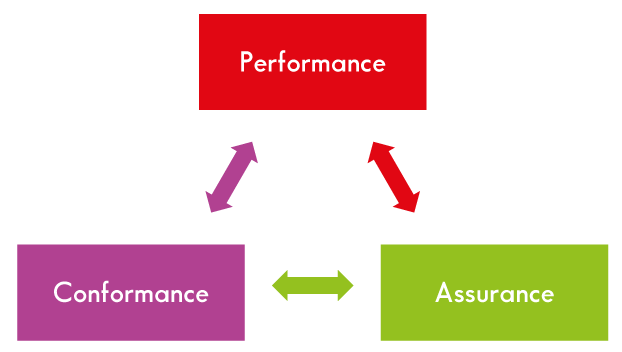
When most executives think of governance they think of compliance and risk management. Many are not aware that corporate governance also has a critical role to play in organisational performance and growth. That said, leading directors are active in the pursuit of value creation and are conscious of the broader social and economic value of good governance.
Governance is an organisational construct designed to facilitate:
- Performance – by better assuring delivery of outcomes consistent with the organisation’s objectives, including appropriate management of organisational risk;
- Conformance – by better assuring the control and accountability of organisations including, importantly, by helping to manage ‘agency risk’.[1]
This definition of governance includes a common link between performance and conformance, and that is assurance.
Assurance has both a formal and informal aspect that includes the policies, processes and protocols of the organisation, as well as the culture of the organisation which drive the behaviour, decision-making and the application of formal assurance mechanisms. It is for this reason that the real value of effective governance is as a team activity, with its primary process being one of collective sense-making.
Effective governance provides the structure to ensure that everyone is ‘on the same page’, has shared objectives and priorities, and understands the cultural norms, polices and processes of the organisation. This ‘shared understanding’ provides for a cohesiveness and resilience that supports the organisation through the phases of its development.
A recent AICD report found three key elements of ‘good governance’ which are all cultural as opposed to structural aspects of a governance framework:
- Perspective — the ability to ensure an accurate assessment of the organisational situation given its complexity and ambiguity.
- Scale — The ability to appropriately frame or understand the implications of decisions taken at one level of the organisation (e.g. business unit or division) on activities and performance at a different level of the organisation (e.g. the overall enterprise or, as in the case of the GFC, on the economy as a whole).
- Prediction — the ability of the team to adequately predict changes in the environment of the organisation at a future point in time. In other words, judging the right time to make a change and the likely impact of any change on different stakeholders over both the short and long term.
It also found that that the challenge of ‘good’ governance is a not a constant one; it changes depending on the circumstances in which the organisation finds itself.[2] This reflects that all organisations transition through cycles of renewal, growth, stability and challenge. The organisations structural governance arrangements may not change through these phases, but it is critical that the informal assurance arrangements are robust and resilient to support the organisation through the transition phases.
It is therefore essential for boards and executive teams to think beyond the formal compliance based governance framework to include the informal cultural aspects of their assurance framework, if they are to ensure ‘effective’ governance and leverage their governance arrangements to not just ensure conformance, but drive improved performance.
[1] www.aicd.com.au
[2] Dr R Kay and Dr C Goldspink, ‘When does good governance lead to better performance?’, www.aicd.com.au







